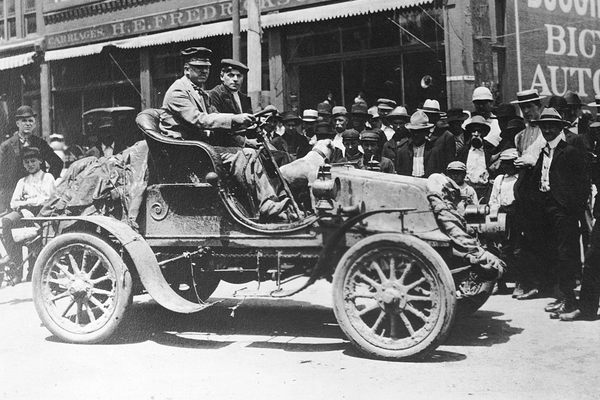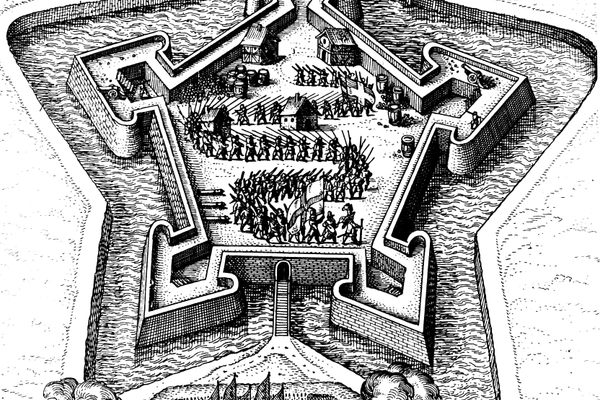Wisconsin’s Long and Winding Road Has a Secret Past
For decades, locals believed landscape architect Jens Jensen designed this twisty stretch of Highway 42—the real history is even more serpentine.
Every summer, thousands of tourists flock to Wisconsin’s Door County peninsula. Businesses shuttered throughout the winter and spring reopen to sell food and souvenirs as people explore the county’s cherry orchards and state parks. At Northport, at the tip of the peninsula, ferries run between the mainland and Washington Island, crossing a channel French sailors nicknamed Porte des Morts or “Death’s Door” for the large number of shipwrecks swept up in the currents.
But right before arriving at Death’s Door, travelers are thrown for a curve—or fifteen to be more specific. An unusually twisty stretch of Highway 42, built in the early 1930s, has baffled visitors for decades. Who designed this surreal stretch of road? All clues would seem to point to the well-known Danish-American landscape architect Jens Jensen, so much so that locals have even nicknamed it, “Jensen’s Road.” And while Jensen did plenty for Door County, from founding a local school to helping layout parks, it turns out the story of Highway 42 is as full of twists as the road itself.
Jensen was born in 1860 to a wealthy farming family who lived near Dybbøl, Denmark. Growing up, Jensen attended Danish folk schools, where he learned about nature and the arts in classes often held outdoors. The experience shaped his lifelong philosophy about the primacy of nature. Jensen would’ve likely stayed in the Danish woodlands all his life if he hadn’t fallen in love with a lower class woman named Anne Marie. Despite his family disapproving of the match, the pair married and moved to start a new life in the United States in 1884, eventually settling in Chicago.
Jensen found a job working for the Chicago Parks District as a street sweeper, but by 1888 he had begun his ascension to become one of the most well-known and sought-after landscape architects in the Midwest. He designed many city parks, including Chicago’s Humboldt Park and the Indiana Dunes State Park, as well as the grounds of schools, libraries, estates, and hospitals.

In 1919, Jensen bought a summer home, a rustic farm settlement on 129 acres in Door County’s Ellison Bay in Wisconsin that he named The Clearing. After his wife passed away in 1934, Jensen, tired of city life, decided to live at The Clearing full-time. From there, he often wrote praises of Door County’s natural beauty, from its pristine pine forests to its lakeside bluffs.
In the last act of his life, Jensen decided to remodel his home at The Clearing to become a folk school, inspired by the ones he had attended as a boy in Denmark. Jensen and other instructors taught landscape construction, nature studies, and art classes. Jensen was also a volunteer member of the Door County Park Board, helping them to acquire and establish state parks, beaches, and roads, and advising on their design.
Jensen, who was described as tall and thin with thick red hair and a bushy mustache, “was particularly passionate about conservation, setting aside parks and preserves before they were destroyed,” says Robert E. Grese, a retired professor of landscape architecture at the University of Michigan and the author of Jensen’s biography, Jens Jensen: Maker of Natural Parks and Gardens.
In his landscape designs, Jensen sought to share his love of natural beauty, says Grese. He insisted on only using plants native to the region. And, as Grese notes, “Jensen loved curves.”
“At his home at The Clearing, he has a curving driveway that leads in. One of his reasons for creating it was that he wanted visitors to slow down to look at the landscape they were passing through,” Grese says. “He felt people coming up to visit from the cities would be forced to take a few deep breaths and relax a bit.”
Jensen viewed straight lines in landscape design as nothing short of a “repression of nature” and associated them with the autocratic societies he left behind in Europe. “Their course points to intellectual decay, which soon develops a prison from which the mind can never escape,” Grese wrote of Jensen’s philosophy.
Combining Jensen’s love of curvy roads, his proximity to the twisting stretch of Highway 42, and his role as a design advisor to Door County, it’s easy to assume that Jensen was the road’s architect, but it turns out that’s not the case—at least, not entirely.
“There is no evidence that Jens Jensen was directly involved with the design of the winding road. He was aware of the project and publicly approved of it,” says Steven Rice, Museum and Archives Manager at the Door County Historical Museum. He points out a letter Jensen wrote to the Door County Advocate in 1935, praising the road after he drove on it.
“Someone with a soul and a love of growing things must have directed this work,” Jensen wrote, noting how “quietly the road winds through the woodlands.”

Rice adds that a museum researcher actually found minutes from a town meeting that named George Schultz, a local farmer and road supervisor, as the head of the highway project. According to oral histories, the road’s shape “came from a desire to avoid cutting down too many trees,” says Rice.
Nonetheless, Jensen still might’ve been involved in the road’s construction. “Oral traditions in northern Door County still make the case for Jensen,” says Rice. “Whether he directly supervised the work, inspired it, or had no direct involvement at all, it is unquestionably in line with his views on the relationship between nature and the built environment.”
Even though the mystery of Jensen’s involvement in Door County’s winding road persists, his legacy in the region will continue to live on. After his death in 1951, Jensen’s secretary Mertha Fulkerson kept The Clearing running, and it still operates today in the same location as a folk school offering classes and workshops.
A few decades later, Jensen had a direct impact on the twisty highway. In the 1970s, planners proposed straightening the road, and Rice says Jensen’s ideas were used publicly to oppose it. A 1973 letter to the Door County Advocate from writer Norbert Blei, for example, quoted Jensen’s writing and noted Jensen’s mindset of “putting trees and the poetry of landscape before people” as a reason to keep the curves.
In 2021, Door County’s two major thoroughfares, Highways 57 and 42, which connect at the tip of the peninsula to form a loop, were designated as a National Scenic Byway, twists and turns included. Today the curvy road still encourages people to slow down and admire the stunning Door County scenery that Jensen loved so much.










































Follow us on Twitter to get the latest on the world's hidden wonders.
Like us on Facebook to get the latest on the world's hidden wonders.
Follow us on Twitter Like us on Facebook